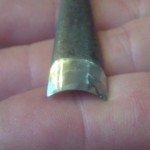 A good place to start is with my video about "Sharpening a Curved Gouge."
A good place to start is with my video about "Sharpening a Curved Gouge."
If you take your time, and don’t try to rush it, you should be fine. The difficulties usually come when the process is rushed (tipping the tool up too much and only the edge is sharpened, for example). It’s a really fast way to get that metal burr, but not great for the sharpening technique!
I tend to use the DMT stones – 1200 (very fine) and 8000 (very very fine). Arkansas stones are good. I have had the opportunity to use a Shapton stone too and was very impressed with them (on my Christmas list).
If I am understanding your question correctly, the angle of the chisel to the stone is 90 degrees. Watch the video again and notice my entire body moves along the edge of the stone which keeps the tool positioned at a 90 degree angle to the stone (not twisting or turning that angle). Be sure to lock your elbows to your sides. Then, unlock your knees and use your legs to rock your body to and fro. That makes a more linear motion than when you pivot from the waist.
When you are first getting comfortable with sharpening, don’t put too much pressure (it can go bad quickly). If you are confident with the position, angle, etc, then you can press down as hard as is comfortable. There are quite often times when I press quite hard and I have pretty significant dents in my fingers where they press on the metal of the gouge. The more pressure or weight you put on the tool, the faster the tool will sharpen.
AAhhh – my favorite! Solving v-chisel dilemmas. So many possibilities of why that tiny little connection between the corner and the straight sides can go wrong. The funny thing is – usually when there is an issue there, too much metal is taken away (therefore a dip in the edge), rather than not enough (therefore a raised point at those sections). Why??? Here are some possibilities:
- There was a flaw in the original shape of the chisel (it’s great when you can blame someone!)
- The slip stone was not rounded, but had a flat corner (often when I purchase a new slipstone, I have to re-shape them on sand paper for a v-chisel because they too often do not have a sharp enough or well-defined corner). If you imagine using this, the inside corner of the v-chisel will never be touched by the slip stone, but these “transition areas” that you are mentioning will get more of a grinding.
- The angle of the bevel may be too sharp, therefore weakening the edge.
- When you round over the outside corner (like you are sharpening a tiny curved gouge) you are somehow sharpening those transition areas more than the curved corner section – maybe rotating it too much? This rounding of the outside “V” should not be rotated all the way to the flat edges – only sharpen the outside corner.
- What is difficult about the v-chisel, is that it could be a combination of several of the above possibilities.
- If it is cutting, I wouldn’t stress too much about it. It just might not look pretty.
The difficulty is, once a v-chisel starts being shaped wrong, it is difficult to straighten it out. I would not take it back to the grinder any more (there is a limit to how much of the end is tempered – I have heard 1/4 to 1/2 inch).
One thing I see people do quite often is grind the end of the v-chisel nice and flat if they are having difficulty in getting the edge even. Then put it on the stone and go through the process of sharpening it. Well, if the reason that the chisel went wrong the first time has not been resolved, the same issues will come back again and again.
It might be easier to explain this theory with a curved gouge example. If I have a gouge that has a flaw in the shape of the inside of the gouge (let’s say there is a rust pit on the inside of the gouge), I try to get a nice flat edge by grinding the end straight (tool blade directly onto the grinder), then when I put the gouge on a sharpening stone, the edge of the gouge will eventually find the pit on the inside of the gouge and the edge of the gouge will be formed based on that – again and again, as long as that flaw is still there.
You could start with just the one slip stone that has a corner for the v-chisel and the other side rounded. Even though the curve won’t fit all the insides of your gouges exactly, you can still run the slip stone along the inside of the curve. Just make sure the slip stone moves along and hits the entire inside edge of the gouge. One stone should work fine.
The process of sharpening is exactly the same for a fishtail as for a curved gouge. Just make sure you don’t twist the tool too much, or those nice sharp corners of the fishtail will be rounded over.
I often only use the strop if I am not using the tool aggressively or with very hard wood. Stropping it brings that fine, sharp edge back.
There are several things to look at – hardness of the wood, what angle you sharpened the tools at, whether you are pushing the gouge through the wood or using a mallet, whether you use the gouge to open paint cans 🙁
It is best to sharpen as you go, but I get caught up in the carving process and just grab a gouge off the shelf that is sharp to replace the dull one. I tend to sharpen them all at once over a few days, but I also have enough gouges to access if some get dull. This isn’t really the best technique if you have a limited set of gouges. So, sharpen as you go.
But on average, if I use a tool a lot, I strop it on leather every hour or so of use. After a full day of use, I usually need to put the tool to a stone again to really bring it back to a sharp edge. This is really if I am using the tool a lot.
I do have the DMT Wave. I believe that is 1200 mesh (or grit). It works OK, as long as you are very careful not to overdo it. With it being such an aggressive grit, it can easily re-shape the inside of the gouge. I have contacted them and asked if they can make it in either a 4000 or 8000 mesh and they said they are experimenting with that and something with the curved surface is making it difficult. I do not use mine unless I purposely want to put an inside bevel on my tool. For just simple honing and removing the burr, I use a shaped Arkansas stone. Removing the burr is such a delicate process and you don’t really want to be re-creating a burr each time you put the slipstone to the tool – which could happen with the DMT Wave if you are not careful.
I am assuming you are referring to hollow ground on the back side, correct? When I first started carving, I had to grind all my gouges on a grinding wheel and creating a hollow ground simply by the shape of the grinding wheel. From what I have seen, the hollow ground makes no difference, so I wouldn’t purposely put one on it. With a flat bevel, the wood clears nicely enough. I would just be cautious about having a double or curved bevel on the back of the gouges as it will cause you to make a more “scooping” cut rather than a slicing cut. One of the potential issues to making a hollow ground is that the blade can tend to be much more fragile and thin.
I tend to sharpen the inside of the gouge without an extra bevel. However some professional carvers add an inside bevel to all their gouges, and sometimes quite aggressive bevels. The main reason for adding an inside bevel is so if you wanted to turn the tool upside down an use the bevel side up, it would allow you to lift the gouge slightly higher above the wood. Keep in mind that the angle of the blade will be less sharp (larger degree angle) if you make an inside bevel, so sometimes the back bevel will need to be adjusted to accommodate this (generally 22.5 degrees is a preferred total angle).
The angle of the blade depends on a lot of things. I’ll be honest – it was only recently when I first measured the angle of my gouges – and it turns out that 22 to 23 degrees is pretty typical. Here are a few things to consider – are you going to be using your gouges in very hard wood or soft wood, like basswood? You can get away with a lower degree angle with soft wood, and higher degree angle with harder woods – just to keep the edge sharp longer. Also, when you are carving, are you needing to lift your hand holding the handle far off the wood? If so, the angle is too large, and the cutting position can get awkward.
Another thing to consider – are you going to be using a mallet a lot to remove or hog out a lot of wood? Increase the angle to strengthen the blade.
The back of the bevel should be flat. The difficulty with having a rounded bevel is that when you carve, it will force you to make scooping cuts and you will need to raise the tool at a higher and more awkward angle in order to start the cut. I like to make “slicing” cuts, and having a rounded bevel will make these cuts difficult to make. It’s OK for hogging out a lot of wood with a mallet because at that point, you just need a sharp tool. But for delicate detail work, try to have the bevel on the back of the tool flat.
You should just be able to clean the stones with soap and water – maybe use a scrub brush? I have never had any problems so far with mine doing this. Make sure you use only water or water and a little “green” dish soap.
